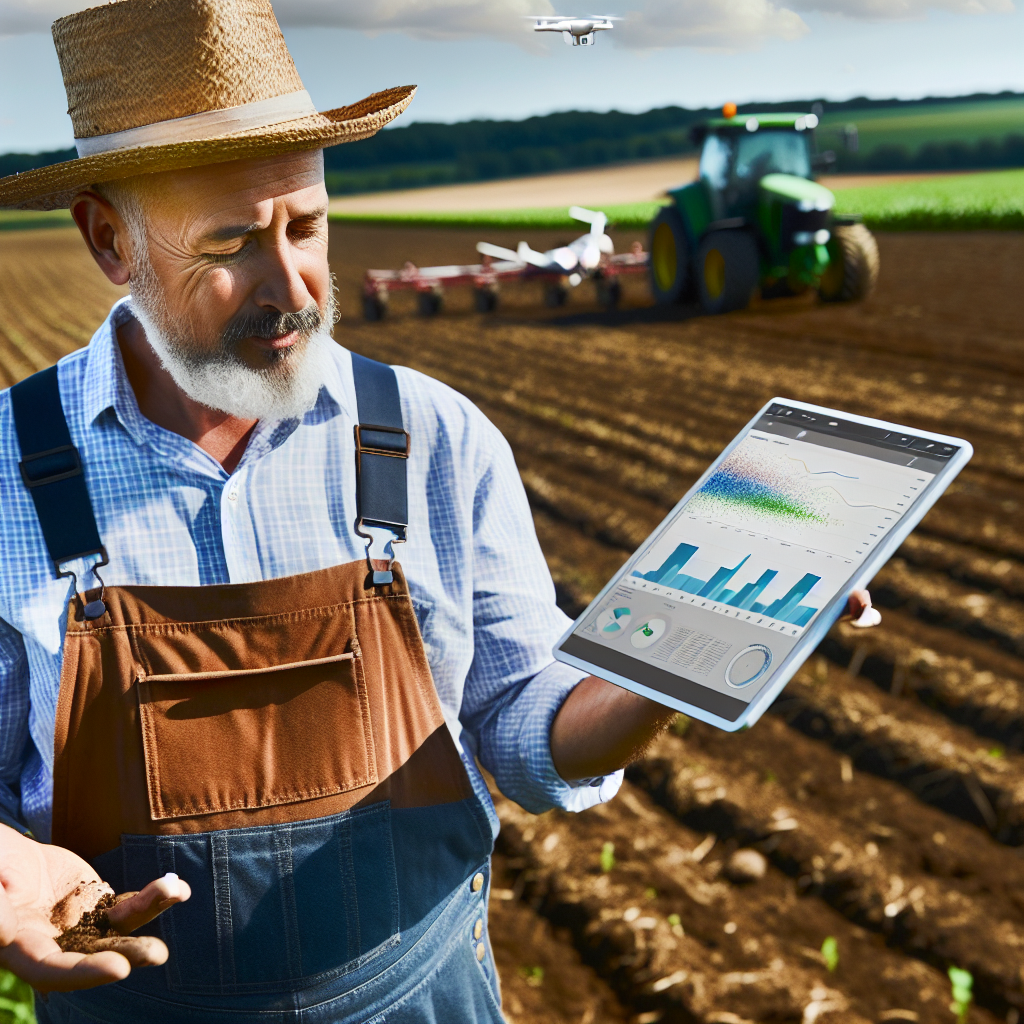Introduction to Sustainable Agriculture and Its Importance
Defining Sustainable Agriculture
Sustainable agriculture focuses on farming practices that are environmentally sound.
It prioritizes the health of ecosystems and promotes biodiversity.
Moreover, it strives to meet current and future food needs.
Importance of Sustainable Farming Practices
Sustainable agriculture plays a critical role in food security.
It helps maintain soil health, ensuring long-term productivity.
Additionally, it reduces the need for synthetic fertilizers and pesticides.
Overall, these practices can mitigate climate change impacts.
Economic Benefits
Implementing sustainable agriculture can drive economic growth in rural areas.
It can create jobs in sustainable farming and related sectors.
Furthermore, sustainable practices can lead to cost savings for farmers.
Community Engagement
Community involvement is essential for the success of sustainable agriculture.
Engaging local farmers fosters knowledge sharing and collaboration.
This collaboration can lead to innovative solutions for challenges.
Global Perspective
Sustainable agriculture is vital on a global scale.
It can help alleviate hunger in developing countries.
Transform Your Agribusiness
Unlock your farm's potential with expert advice tailored to your needs. Get actionable steps that drive real results.
Get StartedAdditionally, it encourages the preservation of natural resources worldwide.
Concept of Partnering for Innovation
Definition and Scope
Partnering for innovation involves collaboration among various stakeholders.
These stakeholders include farmers, researchers, and businesses.
This collaborative effort aims to enhance sustainable agricultural practices.
It focuses on sharing knowledge, resources, and technologies.
Objectives of Partnering for Innovation
The primary objective is to increase productivity sustainably.
Moreover, it aims to reduce environmental impacts from agriculture.
Another goal is to promote economic viability for farming communities.
Equally important is the enhancement of food security.
Key Stakeholders
Farmers play a central role in the innovation process.
They provide practical insights into challenges faced in the field.
Research institutions contribute through scientific advancements.
Additionally, private companies can offer technologies and investment.
Government agencies provide regulatory support and funding.
Importance of Collaboration
Collaboration promotes diverse perspectives on agricultural challenges.
It fosters sharing of best practices across different regions.
Working together can accelerate the pace of innovation.
This synergy can lead to solutions that a single entity might not achieve.
Examples of Successful Partnerships
One effective partnership includes farmers working with technology firms.
These collaborations often lead to precision agriculture innovations.
Additionally, universities partnering with local growers enhance research output.
Such alliances result in practical applications of scientific discoveries.
Key Stakeholders in Sustainable Agriculture Partnerships
Government Agencies
Government agencies play a crucial role in sustainable agriculture.
They develop policies that promote sustainable practices.
Showcase Your Farming Business
Publish your professional farming services profile on our blog for a one-time fee of $200 and reach a dedicated audience of farmers and agribusiness owners.
Publish Your ProfileMany agencies provide funding opportunities for innovative projects.
The U.S. Department of Agriculture actively supports sustainable farming initiatives.
Non-Governmental Organizations (NGOs)
NGOs contribute significantly to sustainable agriculture efforts.
They focus on environmental conservation and advocacy.
Organizations like the World Wildlife Fund promote sustainable farming techniques.
NGOs often collaborate with farmers to enhance their practices.
Research Institutions
Research institutions drive innovation in sustainable agriculture.
They conduct studies to identify effective farming methods.
Colleges and universities offer expertise in sustainable practices.
These institutions often partner with farmers to test new technologies.
Farmers and Agricultural Producers
Farmers are at the heart of sustainable agriculture efforts.
Their willingness to adopt new practices is crucial for success.
Collaboration among farmers can foster community innovation.
Various cooperatives exist to support sustainable initiatives among local producers.
Private Sector Companies
Private sector companies play an essential role in innovation.
They develop products and technologies that enhance sustainability.
Biotechnology firms create crops resistant to pests and diseases.
Agri-tech startups are also emerging with innovative solutions.
Consumers
Consumers influence sustainable practices through their choices.
Demand for organic and sustainably produced food is rising.
Engaged consumers can drive companies to adopt sustainable practices.
Community-supported agriculture (CSA) programs connect consumers with local farmers.
International Organizations
International organizations promote sustainable agriculture on a global scale.
The Food and Agriculture Organization plays a key role in this area.
They provide guidelines and resources to countries worldwide.
Collaboration across borders can enhance food security sustainably.
See Related Content: Preparing the Next Generation for Farm Leadership
Case Studies of Successful Partnerships in Sustainable Farming
Innovative Collaborations
Innovative collaborations drive progress in sustainable agriculture.
One notable example involves the partnership between EcoFarm and GreenTech Solutions.
Together, they developed a precision farming technology that reduces chemical inputs.
This technology helps farmers improve yields while protecting the environment.
Community Engagement
Community engagement plays a crucial role in sustainable farming initiatives.
A great case study is the alliance between FarmFresh and local farmers.
This partnership promotes organic farming practices in the community.
As a result, it increases local food production and reduces carbon footprints.
Public and Private Sector Collaboration
Collaboration between public and private sectors fosters innovation.
The partnership between AgriFuture and governmental agencies exemplifies this strategy.
This collaboration created grants for sustainable farming practices.
Farmers gained access to resources that help them transition to sustainable methods.
Research and Development Partnerships
Research institutions partnering with agricultural companies yield valuable insights.
Showcase Your Farming Business
Publish your professional farming services profile on our blog for a one-time fee of $200 and reach a dedicated audience of farmers and agribusiness owners.
Publish Your ProfileThe partnership between Green Research Institute and CropTech Industries highlights this.
They focused on developing drought-resistant crop varieties.
This innovation helps farmers cope with changing climate conditions effectively.
Case Study: Urban Agriculture Initiatives
Urban agriculture has gained momentum through effective partnerships.
The collaboration between CityFarm and local universities stands out.
They promote rooftop farming in urban areas.
This partnership enhances access to fresh produce and improves urban food security.
Scaling Up Solutions
Successful partnerships often scale up sustainable solutions.
An example is the joint venture between SustainAg and BigHarvest.
This collaboration expanded organic farming across numerous regions.
They established training programs for farmers to adopt sustainable practices.
Gain More Insights: Essential Logistics Tips for Exporting Farm Products
Innovative Technologies Enhancing Sustainable Agriculture
Introduction to Innovative Technologies
Technological advancements drive sustainable agricultural practices forward.
New tools improve efficiency and reduce environmental impacts.
Farmers and companies collaborate to develop these solutions.
Precision Agriculture
Precision agriculture utilizes data analytics to optimize farming practices.
It involves the use of GPS and remote sensing technologies.
Farmers can assess field variability through real-time data.
This approach leads to targeted resource application.
Consequently, it reduces waste and enhances yield.
Vertical Farming
Vertical farming transforms urban spaces into food production hubs.
This method utilizes stacked layers to grow crops indoors.
LED lighting enhances growth efficiency while minimizing space use.
Furthermore, it allows year-round production regardless of climate.
Biotechnology in Crop Production
Biotechnology enables the creation of genetically modified crops.
These crops often possess enhanced resistance to pests and diseases.
Furthermore, they can tolerate adverse conditions, such as drought.
This innovation helps ensure higher yields with fewer resources.
Organic Pest Control
Advancements in organic pest control offer sustainable alternatives.
Integrated pest management focuses on ecological balance.
Biological controls, like beneficial insects, reduce chemical dependency.
Farmers experience fewer negative effects on soil health.
Collaboration and Partnerships
Partnerships between tech companies and agricultural producers accelerate innovation.
Examples include collaborations for drone technology applications.
Such partnerships enhance monitoring and field management practices.
Additionally, shared knowledge fosters community growth and learning.
Future Prospects in Sustainable Agriculture
The future of sustainable agriculture relies on continuous innovation.
Emerging technologies will further revolutionize farming methods.
Collectively, farmers, researchers, and tech developers pioneer new solutions.
This collaboration ensures food security and resource conservation.
Showcase Your Farming Business
Publish your professional farming services profile on our blog for a one-time fee of $200 and reach a dedicated audience of farmers and agribusiness owners.
Publish Your ProfileDelve into the Subject: Global Market Trends Every Farmer Should Know

Role of Research Institutions in Partnering for Innovation
Driving Agricultural Research
Research institutions play a crucial role in advancing agricultural methods.
They conduct studies that identify sustainable practices.
Furthermore, these institutions develop new technologies tailored to local conditions.
Innovation stems from a combination of academic rigor and practical application.
Collaboration with Farmers
Partnerships with farmers enhance the relevance of research findings.
Farmers provide real-world insights and challenges that guide research goals.
This collaboration often leads to improved research outcomes.
Additionally, farmers can test new innovations on their farms.
Engaging with Industry Players
Research institutions also collaborate with agricultural businesses.
These partnerships can accelerate the commercialization of research findings.
Moreover, industry stakeholders bring valuable resources and expertise.
Such collaborations lead to innovative solutions that benefit the entire sector.
Fostering International Connections
Many research institutions build networks that span across borders.
These connections facilitate knowledge sharing and joint research initiatives.
Global partnerships often tackle common agricultural challenges effectively.
Through these alliances, research can adapt best practices from various regions.
Funding and Resource Allocation
Research institutions often require funding to support their initiatives.
They seek grants and partnerships to secure necessary resources.
By pooling resources with other organizations, they maximize impact.
This financial backing enables innovative research projects to launch successfully.
Learn More: Farm Management Software Enhancing Operations
Challenges and Barriers to Effective Partnerships
Understanding the Landscape
Effective partnerships in sustainable agriculture face various challenges.
These challenges can stem from differing priorities among stakeholders.
Moreover, misunderstandings often arise from unclear communication.
Additionally, there can be a lack of trust among partners.
Resource Constraints
One major barrier is the shortage of financial resources.
Small farmers often struggle to secure necessary funding.
Furthermore, access to technology remains limited for many.
All these factors hinder partnership development.
Regulatory Hurdles
Complex regulations can create significant barriers to collaboration.
Farmers and businesses must navigate a maze of policies.
These regulations can differ vastly between regions.
As a result, parties may find it challenging to align their efforts.
Cultural Differences
Cultural differences also play a significant role in partnerships.
Collaboration often requires a strong understanding of diverse values.
Misalignments in goals can lead to frustration and conflict.
Thus, fostering an inclusive environment is crucial for success.
Solutions and Best Practices
Overcoming these barriers requires strategic approaches.
First, open communication must be prioritized among partners.
Showcase Your Farming Business
Publish your professional farming services profile on our blog for a one-time fee of $200 and reach a dedicated audience of farmers and agribusiness owners.
Publish Your ProfileSecond, establishing mutual goals can strengthen collaboration.
Additionally, we must invest in training and resources.
Finally, building networks can connect diverse stakeholders effectively.
Strategies for Building Successful Collaborative Initiatives
Identifying Key Stakeholders
Start by identifying the key stakeholders in sustainable agriculture.
Engage farmers, agronomists, and environmental groups early in the process.
Additionally, involve local communities and consumers to gain diverse perspectives.
This approach fosters trust and ensures all voices are heard.
Establishing Clear Goals
Clearly define the goals of the collaborative initiative.
Ensure these goals align with the principles of sustainable agriculture.
Furthermore, communicate these goals to all participants regularly.
This practice promotes a shared vision and commitment among stakeholders.
Fostering Open Communication
Encourage open communication among all partners involved.
Utilize various platforms for discussions, such as meetings and online forums.
This strategy builds rapport and enhances relationship-building within the team.
Consequently, it leads to more effective problem-solving and innovation.
Encouraging Knowledge Sharing
Promote a culture of knowledge sharing within the initiative.
Organize workshops and training sessions to exchange best practices.
Share research findings and successful case studies openly among stakeholders.
This collaboration enriches everyone’s understanding of sustainable practices.
Creating Operational Frameworks
Develop a clear operational framework for the collaborative effort.
Define roles, responsibilities, and expectations for each participant.
Establish guidelines for decision-making and conflict resolution as well.
Such structures ensure accountability and enhance project effectiveness.
Monitoring and Evaluating Progress
Implement regular monitoring and evaluation of the initiative’s progress.
Use specific metrics to assess the impact of collaborative efforts.
Share evaluation results with all stakeholders to maintain transparency.
This practice fosters continuous improvement and adaptation to challenges.
Building Long-Term Partnerships
Focus on building long-term partnerships beyond individual projects.
Establish strong relationships that encourage ongoing collaboration.
Leverage these partnerships for future initiatives in sustainable agriculture.
Ultimately, create a supportive network that benefits all members.
Additional Resources
European Partnership “Agriculture of Data” Strategic Research and …
Mya O. Price, Ph.D. – Assistant Professor, Global Food Institute – The …




